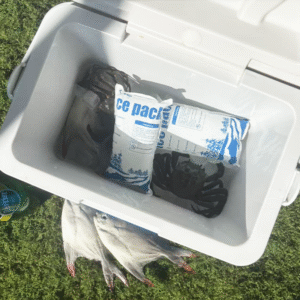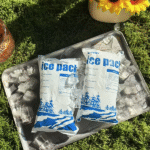Pack de glace carbonique pour conteneur d'expédition: Comment assurent-ils un contrôle sûr de la température pendant le transport?
Dans l'industrie de la logistique de la chaîne du froid, il est crucial de garantir que les produits sensibles à la température restent dans une plage spécifiée. Packs de glace sèche pour conteneurs d'expédition sont essentiels au maintien de l’intégrité des produits périssables pendant le transport. Ces packs de glace offrent une solution efficace et économique, en particulier pour les expéditions longue distance, s'assurer que les articles périssables comme les produits pharmaceutiques, nourriture, et les échantillons biologiques arrivent à bon port. Dans cet article, nous explorerons le fonctionnement des packs de glace carbonique dans les conteneurs d'expédition, leurs avantages, meilleures pratiques pour une utilisation, et comment ils aident à résoudre les défis courants liés au transport sous chaîne du froid.

Que sont les packs de glace carbonique pour conteneurs d'expédition et comment fonctionnent-ils?
Glace sèche, qui est la forme solide du dioxyde de carbone (CO2), a un point de sublimation de -78,5°C (-109.3°F). Lorsqu'il est placé à l'intérieur d'un conteneur d'expédition, les blocs de glace carbonique assurent un refroidissement continu en absorbant la chaleur lorsqu'ils se subliment du solide au gaz. Ce processus de refroidissement maintient l'intérieur du conteneur d'expédition à une température constamment basse., ce qui le rend idéal pour les expéditions sensibles à la température. Contrairement aux blocs de glace classiques qui fondent dans l'eau, La glace sèche sublime directement dans le gaz, éliminant tout risque de fuite d’eau pouvant potentiellement endommager les marchandises.
Les blocs de glace carbonique offrent une solution de refroidissement plus efficace que les méthodes traditionnelles, ce qui les rend particulièrement utiles pour expédier des aliments surgelés, médicaments, et des échantillons biologiques, qui doivent maintenir des températures spécifiques pendant le transport.
Pourquoi les packs de glace carbonique sont-ils essentiels pour le contrôle de la température pendant le transport?
Les blocs de glace carbonique sont essentiels pour contrôler la température des denrées périssables pendant le transport. Leurs capacités à ultra-basse température maintiennent les expéditions à des températures inférieures à zéro., ce qui est crucial pour les produits qui doivent rester congelés ou réfrigérés pour conserver leur qualité.
-
Refroidissement efficace: La glace carbonique peut maintenir des températures très basses pendant de longues périodes, beaucoup plus longtemps que les packs de glace ou de gel traditionnels. Cette efficacité réduit le besoin de réapprovisionnement fréquent lors de longues expéditions.
-
Pas de dégâts d'eau: Puisque la glace sèche sublime directement dans le gaz, il élimine le risque de fuite d'eau, un problème courant avec la glace conventionnelle, ce qui peut endommager les produits et emballages sensibles.
-
Compact et facile à manipuler: Les blocs de glace carbonique sont faciles à manipuler et peuvent être placés avec précision à l'intérieur des conteneurs d'expédition pour assurer une répartition uniforme du froid., s'assurer que chaque article reste dans sa plage de température optimale.
Meilleures pratiques d’utilisation des packs de glace sèche dans les conteneurs d’expédition
Pour maximiser l’efficacité des blocs de glace carbonique dans vos expéditions, il est important de suivre quelques bonnes pratiques:
1. Isolation appropriée
Le conteneur d'expédition doit être suffisamment isolé pour retenir l'air froid généré par la neige carbonique.. L'isolation réduit la vitesse à laquelle la neige carbonique se sublime, s'assurer que la température à l'intérieur du conteneur reste stable pendant toute la durée du transport. Des matériaux comme la mousse de polystyrène, mousse de polyuréthane, et les panneaux isolés sous vide sont couramment utilisés pour recouvrir les conteneurs d'expédition.
2. Évitez de surcharger la glace carbonique
Les réglementations en matière d'expédition limitent généralement la quantité de neige carbonique pouvant être utilisée dans un seul envoi.. Le dépassement de ces limites peut entraîner des conditions dangereuses pendant le transport, surtout dans les espaces confinés. Assurez-vous que la quantité de neige carbonique utilisée est conforme aux directives réglementaires, ne dépassant généralement pas 5.5 livres par colis pour les expéditions aériennes.
3. Étiquetage et ventilation
Un étiquetage et une ventilation appropriés sont essentiels pour la sécurité lors de l'expédition de glace carbonique. Les conteneurs doivent être clairement marqués « Glace sèche » ou « Dioxyde de carbone »., Solide » et inclure l’identifiant UN1845. Il est crucial de s'assurer que le conteneur est bien ventilé pour permettre au gaz CO2 de s'échapper au fur et à mesure que la neige carbonique se sublime., empêcher l'accumulation de pression qui pourrait conduire à des accidents.
| Cas d'utilisation de l'expédition | Plage de température idéale | Produits courants | Exigences en matière de glace carbonique |
|---|---|---|---|
| Expédition pharmaceutique | -10° C à -20 ° C | Vaccins, Insuline | 5-10 livres de glace carbonique |
| Expédition alimentaire | -18° C ou plus bas | Repas surgelés, Fruit de mer | 8-12 livres de glace carbonique |
| Échantillons biologiques | -20° C ou plus bas | ADN, Échantillons de sang | 6-10 livres de glace carbonique |
Défis liés à l’utilisation de glace carbonique dans le transport maritime et leurs solutions
L’utilisation de neige carbonique dans les conteneurs maritimes n’est pas sans défis. Cependant, avec la bonne préparation, ces défis peuvent être gérés efficacement.
1. Taux de sublimation sur glace carbonique
La glace carbonique se sublime à un rythme spécifique, typiquement 3 à 8 livres par jour en fonction de facteurs tels que l'isolation et la température ambiante. Pour contrecarrer cela, utiliser une isolation de conteneur appropriée et surveiller le processus de sublimation. Cela garantit que la glace carbonique reste efficace tout au long du voyage., même pour des expéditions plus longues.
2. Problèmes de sécurité liés au gaz CO2
Le principal problème de sécurité avec la neige carbonique est le gaz CO2 qui est libéré lors de la sublimation.. L'excès de CO2 peut déplacer l'oxygène de l'air, Posant les risques d'asphyxie. Assurer une bonne ventilation dans le conteneur d’expédition est essentiel pour éviter ces dangers.
3. Conformité aux réglementations d'expédition
Différents transporteurs et pays ont des réglementations différentes concernant l'expédition de neige carbonique. Le respect de ces réglementations est essentiel pour éviter des retards ou des amendes.. Par exemple, L'Association internationale des transports aériens (Iata) a des directives spécifiques pour l’expédition de glace carbonique qui doivent être suivies.
Comment la glace carbonique et les packs de gel fonctionnent ensemble pour garantir un transport sûr
La combinaison de glace carbonique et de packs de gel est un moyen efficace de maintenir différentes zones de température dans le même conteneur d'expédition.. La glace carbonique est idéale pour les températures extrêmement froides, tandis que les packs de gel maintiennent une plage de refroidissement modérée. Ce système de refroidissement hybride permet aux entreprises d'expédier des produits nécessitant des conditions de température différentes en une seule expédition.. Par exemple, vous pouvez placer des packs de gel à proximité d'aliments sensibles à la température, tandis que la glace carbonique peut être placée à proximité des articles congelés.
Principaux avantages du refroidissement hybride
-
Durée de refroidissement prolongée: La combinaison de glace carbonique et de packs de gel prolonge la période de refroidissement globale, ce qui est crucial pour les expéditions long-courriers.
-
Rentable: L'utilisation de packs de gel avec de la neige carbonique réduit la quantité totale de neige carbonique requise, ce qui réduit les coûts et réduit l’impact environnemental.
-
Sécurité améliorée: Les packs de gel sont plus sûrs à manipuler, et l'utilisation des deux agents de refroidissement réduit le risque d'engelures associées à la manipulation de glace carbonique.
Tendances en matière d’expédition de glace carbonique pour 2025
Le secteur de la logistique de la chaîne du froid continue d'évoluer avec des progrès qui améliorent l'efficacité et la durabilité des méthodes d'expédition de glace carbonique.. Certaines des dernières innovations incluent:
Technologie d'emballage intelligente
Les conteneurs maritimes sont désormais équipés de capteurs intelligents qui surveillent les fluctuations de température en temps réel. Ces capteurs fournissent des alertes immédiates si la température dépasse les limites acceptables, permettant une action corrective rapide.
Initiatives de durabilité
Alors que la durabilité devient une priorité, les entreprises cherchent des moyens de réduire l’impact environnemental du transport de glace carbonique. Cela inclut l'utilisation de matériaux d'emballage respectueux de l'environnement et l'exploration de méthodes durables de production de glace sèche..
Automatisation en logistique
L’automatisation révolutionne la logistique de la chaîne du froid, réduire les erreurs humaines et augmenter l’efficacité. Les systèmes automatisés aident à la manipulation, transport, et suivi des expéditions de glace carbonique, ce qui rend le processus global plus rationalisé.
FAQ courantes sur l’expédition de glace carbonique
Q1: Combien de temps dure la neige carbonique dans un conteneur d'expédition?
La glace sèche dure généralement entre 24 et 72 heures, en fonction de la qualité de l'isolation et de la quantité utilisée.
Q2: Puis-je utiliser de la neige carbonique pour expédier de la nourriture?
Oui, la glace carbonique est couramment utilisée pour expédier des aliments surgelés, surtout ceux qui nécessitent des températures inférieures à -18°C, comme les fruits de mer et les plats surgelés.
Q3: La glace sèche est-elle sûre à manipuler?
La glace carbonique peut être manipulée en toute sécurité avec les précautions appropriées. Portez toujours des gants pour éviter les engelures et assurez-vous que le conteneur d'expédition dispose d'une ventilation adéquate pour libérer le gaz CO2 en toute sécurité..
Résumé et recommandations
En conclusion, Les blocs de glace sèche pour conteneurs d'expédition sont un outil essentiel pour la logistique de la chaîne du froid, garantir que les marchandises sensibles à la température restent dans la plage de température souhaitée tout au long du transport. En suivant les bonnes pratiques en matière d'emballage, manutention, et la sécurité, les entreprises peuvent améliorer leurs processus d'expédition et garantir l'intégrité de leurs produits.
Étapes suivantes
-
Passez en revue vos processus d’expédition: Assurez-vous que la glace carbonique est adaptée à vos produits et répond à toutes les exigences de température.
-
Formez votre équipe: Assurez-vous que votre équipe connaît bien la manipulation sécuritaire et les réglementations associées à la glace carbonique..
-
Restez à jour sur les tendances de l'industrie: Tenez-vous au courant des dernières tendances en matière de logistique sous chaîne du froid, tels que les emballages intelligents et les efforts de développement durable.
À propos du tempk
Et tempk, nous sommes spécialisés dans la fourniture de solutions de chaîne du froid adaptées à vos besoins d'expédition. En mettant l’accent sur l’innovation et la qualité, nos produits assurent une fraîcheur et une sécurité optimales pour vos produits sensibles à la température. Contactez-nous dès aujourd'hui pour savoir comment nous pouvons vous aider à améliorer vos opérations d'expédition grâce à nos solutions de pointe de glace carbonique..























